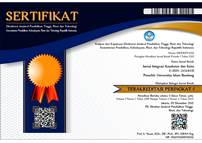Fraksi Jahe Gajah (Zingiber officinale roscoe) Memengaruhi Mikrostruktur Epikardium dan Dinding Arteri Koroner pada Hewan Model Sindrom Metabolik
Abstract
Penyakit jantung koroner (PJK) merupakan penyebab kematian utama di dunia. Satu dari seluruh faktor risiko utama penyakit jantung adalah karena dislipidemia. Dislipidemia merupakan kondisi awal sindrom metabolik yang dapat menyebabkan coronary atherosclerosis dan penebalan epikardium. Jahe gajah (Zingiber officinale roscoe) memiliki komponen polyphenol yang dapat melawan stres oksidatif serta memiliki efek antihiperkolesterolemia dan antiaterogenik. Tujuan penelitian ini adalah menganalisis pengaruh fraksi jahe gajah terhadap ketebalan epikardium dan gambaran dinding arteri koroner. Penelitian ini merupakan penelitian eksperimental laboratorium murni in vivo dengan 24 mencit jantan tua (50–60 minggu) galur Swiss Webster yang terbagi menjadi satu kelompok kontrol dan tiga kelompok perlakuan yang diberi fraksi etil asetat jahe gajah secara per oral selama 27 hari dengan konsentrasi yang berbeda. Kemudian, subjek dikorbankan untuk diambil organ jantung dan dilakukan pembuatan sediaan histologis dengan pewarnaan hematoxylin eosin. Hasil penelitian menunjukkan bahwa epikardium kelompok perlakuan lebih tipis dibanding dengan kelompok kontrol, sedangkan dinding arteri koroner kelompok perlakuan menunjukkan bentuk bulat tanpa kolaps dibanding dengan dinding arteri koroner kelompok kontrol. Hasil ini membuktikan sifat antihiperkolesterolemia dan antiaterogenik dari zat yang terkandung pada jahe gajah. Simpulan, fraksi jahe gajah memengaruhi lapisan epikardium dan arteri koroner pada hewan model sindrom metabolik.
EFFECTS OF GINGER FRACTION (ZINGIBER OFFICINALE ROSCOE) TO EPICARDIAL LAYER AND CORONARY ARTERIAL WALL MICROSTRUCTURE IN METABOLIC SYNDROME ANIMAL MODELS
Cardiovascular disease is the major cause of death in the world. The most common risk factor of cardiovascular disease is caused by dyslipidemia. Dyslipidemia is early condition from metabolic syndrome which causes coronary atherosclerosis and epicardial thickening. Ginger has polyphenol components which able to oppose oxidative stress and has anti-hypercholesterolemia and anti-atherogenic effects. The objective of this study was to analyze the effects of ginger fraction to epicardial layer and coronary arterial wall microstructure. This research was an in vivo experimental study with 24 males Swiss Webster mices (50–60 weeks old) which divide into one control group and three intervention groups which was given a fraction orally in 27 days with different concentration for each group. Then the subjects were sacrificed into histological preparations with hematoxylin eosin staining. The result of this study shows that epicardial layer in intervention groups was thinner than epicardial layer in control group meanwhile coronary arterial wall in intervention groups showed normal findings (round lumens and without collapse). These results show anti-hypercholesterolemia and anti-atherogenic effect from active substance in ginger fraction. The conclusion of the study explains that ginger fraction has effects to epicardial layer and coronary arterial wall microstructure in animal model with metabolic syndrome.
Keywords
Full Text:
PDFReferences
Mozaffarian D, Benjamin Emilia J, Go Alan S. Heart disease and stroke statistics-2016 Update. AHA J. 2016;133:e38–e60.
Kemenkes RI. Info Datin Pusat Data dan informasi Kementrian Kesehatan RI. Jakarta: Kemenkes RI; 2014.
Tsukinoki R, Murakami Y. Non-communicable disease epidemic: epidemiology in action (EuroEpi 2013 and NordicEpi 2013): Aarhus, Denmark from 11 August to 14 August 2013. Eur J Epidemiol. 2013 Aug;28 Suppl 1:S5–270.
Horton R. Non-communicable diseases: 2015 to 2025. Lancet. 2013;381(9866):509–10.
Kaur J. Assessment and screening of the risk factors in metabolic syndrome. Med Sci. 2014;2(3):140–52.
Rafieian-Kopaei M, Setorki M, Doudi M, Baradaran A, Nasri H. Atherosclerosis: process, indicators, risk factors and new hopes. Int J Prev Med. 2014;5(8):927–46.
Killer H. Part II Anti Ischemic Drugs. 2013.
Weiss P, Ritz R. Analgesic effect and side-effects of buprenorphine in acute coronary heart disease. A randomized double-blind comparison with morphine. Anasth Intensivther Notfallmed. 1988;23(6):309–12.
Attokaran M. Ginger. Natural food flavors and colorants. New Jersey: John Wiley & Sons Ltd; 2011.
Pilerood SA, Prakash J. Chemical composition and antioxidant properties of ginger root (Zingiber officinale). J Med Plant Res. 4(24):2674–9.
Alqasoumi SI. Quantification of 6-gingerol in Zingiber officinale extract, ginger-containing dietary supplements, teas and commercial creams by validated HPTLC densitometry. Fabad J Pharmaceut Sci. 2009;34(1):33–42.
Nicoll R, Henein MY. Ginger (Zingiber officinale Roscoe): a hot remedy for cardiovascular disease? Int J Cardiol. 2009;131(3):408–9.
Yulianti AB, Rahmawaty I. Efek proteksi campuran ekstrak bawang putih, jahe gajah dan lemon terhadap kadar kolesterol total darah pada tikus tua yang terpapar diet tinggi lemak. Prosiding SNaPP2017 Kesehatan. 2017;3(1):215–21.
Baixeras SS, Ganella CL, Lucas G, Elosua R. Pathogenesis of coronary artery disease: Focus on genetic risk factors and identification of genetic variants. Appl Clin Genet. 2014;7:15–32.
Gharipour M, Asadi-Samani M. The protective effects of ginger on the development of coronary atherosclerosis: An experimental animal study. Der Pharm Lett. 2016;8(3):105–9.
DOI: https://doi.org/10.29313/jiks.v1i2.4353
Refbacks
- There are currently no refbacks.
Jurnal Integrasi Kesehatan dan Sains is licensed under a Creative Commons Attribution-NonCommercial-ShareAlike 4.0 International License.







.png)
_(1).png)





















